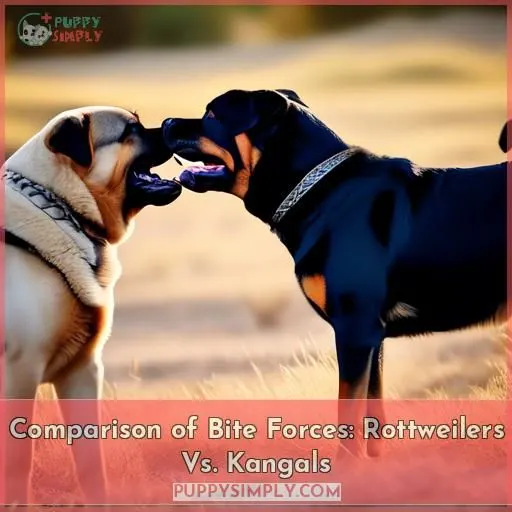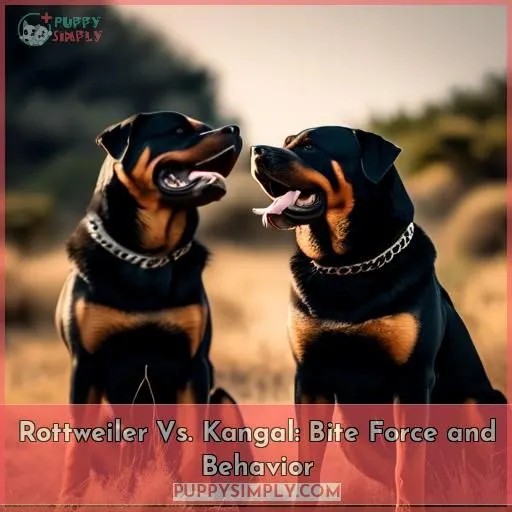This site is supported by our readers. We may earn a commission, at no cost to you, if you purchase through links.
 You’ve heard about the Rottweiler’s powerful bite, but did you know the Kangal’s jaw strength is over twice as strong?
You’ve heard about the Rottweiler’s powerful bite, but did you know the Kangal’s jaw strength is over twice as strong?
With a bite force of 743 PSI, the Kangal’s bone-crushing ability surpasses the Rottweiler’s 328 PSI.
While impressive, bite force alone doesn’t determine aggression – proper training and socialization are essential for both breeds.
Their protective instincts require responsible ownership to channel their power appropriately.
If you’re intrigued by this comparison of canine jaw power, you’ll uncover deeper insights as we explore further.
Table Of Contents
- Key Takeaways
- Breed Characteristics of Rottweilers and Kangals
- Rottweiler Bite Force: Myths and Reality
- Kangal Bite Force: the Strongest Among Dog Breeds
- Comparison of Bite Forces: Rottweilers Vs. Kangals
- Rottweiler Vs. Kangal: Bite Force and Behavior
- Kangal Bite Force: Comparison to Wild Animals and Humans
- Bite Force in Rottweilers and Kangals: in Vivo and in Vitro Studies
- Training and Socialization: Importance for Rottweilers and Kangals
- Dog Breeds With Strongest Bite Force: Mastiff, Cane Corso, Akita, Siberian Husky
- Dog Attack Prevention Tips: Importance of Training and Socialization
- Frequently Asked Questions (FAQs)
- What is the difference in bite force between Kangals and Rottweilers?
- How does Kangal’s bite force compare to other animals?
- What are the training and socialization requirements for Kangals?
- How does Kangal’s bite force affect its role as a guard dog?
- What is the myth about Kangal’s bite force and locking jaw?
- Conclusion
Key Takeaways
- Rottweilers have a bite force of 328 PSI, while Kangals have an impressive bite force of 743 PSI, which is more than twice as strong.
- Proper training and socialization are essential for both breeds to channel their power appropriately and prevent aggressive behavior.
- Kangals are generally not aggressive and only bite when provoked or perceive a threat, while Rottweilers can exhibit confrontational behavior without adequate socialization.
- Bite force alone doesn’t determine aggression, and responsible ownership is crucial to ensure these powerful dogs are well-behaved and safe around children and other animals.
Breed Characteristics of Rottweilers and Kangals
Rottweilers and Kangals are two distinct breeds with unique characteristics and bite force abilities. Rottweilers are renowned for their protective instincts and loyalty, making them formidable guard dogs. They possess a bite force of 328 PSI, which is twice their body weight and ranks them 12th on the scale of strongest bite force dogs. Kangals, conversely, are bred for their strength and agility, making them ideal protectors of livestock. Their bite force is markedly stronger, measuring an impressive 743 PSI, which is more than double the bite strength of Rottweilers.
In terms of temperament, Rottweilers can exhibit confrontational behavior without adequate socialization, while Kangals are generally not aggressive and only bite when provoked or perceive a threat. Both breeds necessitate proper training and socialization to guarantee their good behavior and safety around children and other animals.
When comparing the bite forces of these two breeds, it’s crucial to account for factors such as skull size, shape, and potential health issues. Brachycephalic breeds, like Rottweilers, possess a higher bite force than dolichocephalic breeds. Additionally, Kangals boast the strongest bite force among all dog breeds, and with proper training, their bite force remains stable around children.
Rottweiler Bite Force: Myths and Reality
Rottweiler bite force has fascinated many dog enthusiasts and researchers. While Rottweilers are renowned for their powerful bite, averaging 328 PSI, it’s essential to comprehend the context surrounding this measurement. Bite force alone doesn’t determine a dog’s propensity for aggression or hazard. Rottweilers are generally regarded as well-natured when adequately trained and socialized. Nevertheless, several common misconceptions exist about their bite force and the notion of lockjaw.
Here are four key points to ponder when comparing Rottweiler bite force:
-
Bite force measurement: Bite force is typically gauged in pounds per square inch (PSI). A bite force of 328 PSI is substantial, but it’s merely one facet of a dog’s behavior and disposition.
-
Training efficacy: Appropriate training and socialization are imperative for any breed, including Rottweilers. A well-trained and socialized Rottweiler is less inclined to display aggressive conduct.
-
Socialization influence: Inadequately socialized Rottweilers may exhibit temperament variations. Limited exposure to diverse environments and experiences can heighten the risk of aggressive behavior.
-
Temperament distinctions: Rottweilers are protective and steadfast, which can occasionally be misapprehended as aggression. Most aggressive tendencies in Rottweilers stem from insufficient training, lack of socialization, or traumatic experiences.
Kangal Bite Force: the Strongest Among Dog Breeds
The Kangal breed exhibits the most formidable bite force among all dog breeds, with a jaw strength of 743 PSI. This exceeds the bite strength of Rottweilers by more than two times, often regarded as a powerful breed.
The Kangal’s bite force serves as a warning to potential threats, rendering them exceptional protectors for livestock and humans. However, it’s imperative to recognize that Kangals are generally not aggressive and only resort to biting when provoked or sensing a threat.
With appropriate training and socialization, they can become suitable companions. The Kangal’s bite force showcases their protective nature, but it’s paramount to understand that these dogs aren’t inherently dangerous.
Training and socialization are essential to ensure their bite force is utilized for protection, not aggression.
Comparison of Bite Forces: Rottweilers Vs. Kangals
As we’ve seen, the Kangal boasts a bite force that’s the stuff of legends, but how does it stack up against the Rottweiler’s chomp? Let’s sink our teeth into the meat of the matter:
- The Kangal’s bite force of 743 PSI is a heavyweight champion, towering over the Rottweiler’s respectable 328 PSI.
- While the Rottweiler’s bite is no tickle, it’s about as half as mighty as the Kangal’s, which could make a wolf think twice.
- Training requirements for these canine titans are as essential as a sturdy leash, ensuring their power is matched by obedience.
- Temperament assessment is key; both breeds pack a punch, but with the right socialization methods, they’re more likely to smother you in slobbery kisses than snarls.
Rottweiler Vs. Kangal: Bite Force and Behavior
When comparing the bite force of Rottweilers and Kangals, it’s essential to take into account the breed characteristics, genetics, environment, training, temperament, and health. Rottweilers, with a bite force of 328 PSI, are renowned for their protective instincts and can become confrontational without proper socialization. Kangals, on the other hand, have a bite force of 743 PSI, making them the most powerful among all dog breeds. They’re bred to shield livestock from predators and can serve as exceptional protectors for homes and farms.
The behavior of these breeds is shaped by their genetics and environment. Adequate training and socialization are paramount to prevent aggressive behavior. Rottweilers may be more likely to bite due to their protective instincts, while Kangals are generally not aggressive unless provoked or sense a threat. Health issues can also affect bite force and behavior in both breeds.
In a 2×2 table, we can compare the bite force and behavior of Rottweilers and Kangals:
| Breed | Bite Force (PSI) | Behavior |
|---|---|---|
| Rottweiler | 328 | Protective, can become confrontational |
| Kangal | 743 | Bred for protection, usually not aggressive |
Understanding the bite force and behavior of these breeds can assist owners in making informed decisions about their suitability as pets or working animals. Proper training and socialization are key to ensuring these dogs are well-behaved and safe around children and other animals.
Kangal Bite Force: Comparison to Wild Animals and Humans
Kangals, with a bite force of 743 PSI, are the strongest biters among all dog breeds. They were bred to protect livestock from predators, and their powerful bite force is crucial for this role.
Compared to wild animals, a Kangal’s bite force is notably weaker than that of a saltwater crocodile, which has the strongest bite force of any living animal at 4,000 PSI. Other animals with strong bite forces include the hippopotamus (2,000 PSI), jaguar (1,500 PSI), and great white shark (4,000 PSI).
Despite their strong bite force, Kangals are typically not aggressive and only bite when provoked or perceive a threat. They can make suitable pets if trained and socialized appropriately.
Bite Force in Rottweilers and Kangals: in Vivo and in Vitro Studies
In vivo and in vitro studies play a vital role in comprehending the bite force of various dog breeds, including Rottweilers and Kangals. In vivo studies involve measuring the bite force in anesthetized dogs by using electrical stimulation of the muscles, while in vitro studies are based on computer models that simulate the anatomical structures of the jaw.
In the case of Rottweilers, in vivo studies have shown that their bite force isn’t as powerful as previously thought. The erroneous belief that Rottweilers have a bite force of 2000 pounds per square inch (PSI) was likely based on a study that measured the bite force in Newtons, which is equivalent to 0.22 pounds of force. When converted to PSI, the average bite strength of the dogs in the study comes out to be around 450 PSI, which is close to the actual bite force of Rottweilers.
On the other hand, Kangals have the strongest bite force among all dog breeds, with a PSI of 743. This is more than double the bite strength of Rottweilers and three times stronger than the Doberman Pinscher. Despite their impressive bite force, Kangals are surprisingly even-tempered, especially around children, and can be trained to be exceptional companions.
It is imperative to note that bite force isn’t the sole factor that determines a dog’s potential for aggression or danger. Adequate training and socialization are essential for any breed, including Rottweilers and Kangals, to ensure they’re well-behaved and pose no threat to others.
Training and Socialization: Importance for Rottweilers and Kangals
Training and acculturation are essential for both Rottweilers and Kangals to avert aggressive behavior and guarantee compliance. Rottweilers, renowned for their guardian instincts, can become confrontational without proper acculturation, leading to potential aggression. Kangals, bred to safeguard livestock, can also exhibit aggressive behavior if not adequately trained and acculturated.
Training and acculturation assist in modifying behavioral traits, rendering these breeds more compliant and less prone to displaying aggressive behavior. Acculturation is indispensable from a tender age, exposing puppies to diverse environments and experiences to aid their development into well-rounded canines. Training, conversely, imparts commands and boundary comprehension to canines, diminishing the probability of aggressive behavior.
In the instance of Kangals, training can also assist them in discerning between perceived threats and their owners, ensuring they prioritize protection rather than posing a threat. For Rottweilers, training can facilitate the redirection of their guardian instincts towards their owners, rather than towards perceived threats.
Dog Breeds With Strongest Bite Force: Mastiff, Cane Corso, Akita, Siberian Husky
Rottweilers and Kangals are both formidable dog breeds with distinctive traits. Rottweilers possess a bite force of 328 PSI, surpassing their weight and ranking second among dog breeds in bite strength. Kangals, however, hold the record for the most potent bite force, reaching an astonishing 743 PSI. This formidable attribute renders them exceptional guardians for livestock and humans.
When evaluating the bite force of these breeds, it’s crucial to acknowledge the impact of training and socialization in shaping their behavior. Rottweilers are renowned for their unwavering determination and jaw lock mechanism, which amplify the severity of their bite force. In contrast, Kangals exhibit a generally non-aggressive nature, only resorting to biting when threatened or provoked. Both breeds are capable of inflicting significant damage, but the bite force of a Kangal is notably more potent.
Beyond Rottweilers and Kangals, other breeds with robust bite forces include the Mastiff (700 PSI), Cane Corso (700 PSI), Akita (300-400 PSI), and Siberian Husky (250-300 PSI). These breeds also possess the potential to cause serious harm if not adequately trained and socialized.
To safeguard the well-being of humans and animals, it’s imperative to prioritize proper training and socialization for these breeds. This entails instilling bite inhibition, fostering an understanding of body language, and ensuring safe playtime. By implementing these measures, we can mitigate the risk of biting incidents and foster harmonious relationships with these powerful canines.
Dog Attack Prevention Tips: Importance of Training and Socialization
As a responsible dog owner, comprehending your breed’s bite strength and demeanor is imperative for preventing dog attacks. Rottweilers and Kangals both possess formidable bite forces, but their behavior and training can have a marked impact. Here are five essential recommendations for training and socialization:
- Training methods: Guarantee that your dog receives appropriate training from an early age. This encompasses basic obedience, socialization, and bite inhibition.
- Socialization tactics: Introduce your dog to diverse environments, individuals, and other animals to foster positive interactions and mitigate fear or aggression.
- Careful ownership: Consistently supervise your dog’s interactions with others and intervene when necessary to avert potential conflicts.
- Breed-specific regulations: Acquaint yourself with any breed-specific legislation in your area and ensure your dog adheres to them.
- Community engagement: Participate in community events, dog parks, and training classes to connect with other dog owners and gain insights from their experiences.
Frequently Asked Questions (FAQs)
What is the difference in bite force between Kangals and Rottweilers?
You won’t believe the difference – the mighty Kangal’s bite crushes with over twice the force of a Rottweiler at 743 PSI! That’s one powerful chomp you don’t want any part of.
How does Kangal’s bite force compare to other animals?
You wouldn’t want to get chomped by a Kangal! Their 743 PSI bite force is stronger than a grizzly bear’s and can crush bones. Only crocodiles and sharks top their jaw power in the animal kingdom. Now that’s an impressive set of chompers!
What are the training and socialization requirements for Kangals?
You’ll need to socialize and properly train Kangals from an early age. They’ve powerful protective instincts, so consistent positive reinforcement is key. With the right upbringing, Kangals can be loyal, loving companions – but their bite force demands responsible ownership.
How does Kangal’s bite force affect its role as a guard dog?
A Kangal’s 743 PSI bite force? You’ve got an apex predator guarding your home! Their strength allows confident confrontation while training promotes control. Talk about feeling safe – that’s power you can rely on.
What is the myth about Kangal’s bite force and locking jaw?
There’s no such thing as a locking jaw in dogs – that’s an old wives’ tale. A Kangal’s powerful bite comes from its massive jaw muscles and skull structure, not some mythical locking mechanism. With training, that force is focused on protecting, not harming.
Conclusion
With jaw forces ranging from 328 PSI for Rottweilers to a staggering 743 PSI for Kangals, these breeds possess immense bite strengths. However, responsible ownership through proper training and socialization is paramount when comparing rottweiler bite force vs kangal bite force. Guiding their protective instincts appropriately ensures these powerful canines become well-behaved companions, not potential threats.
















